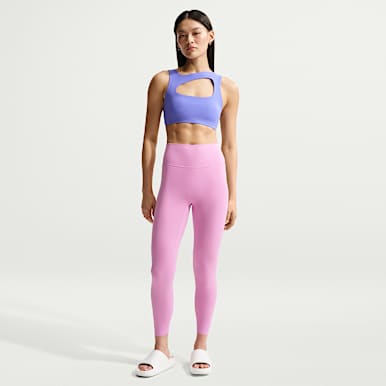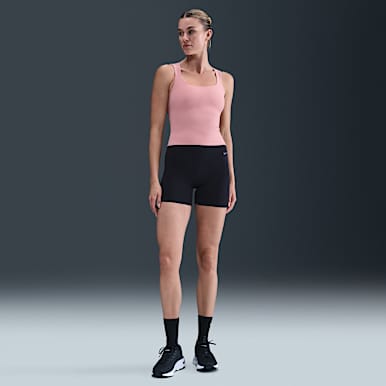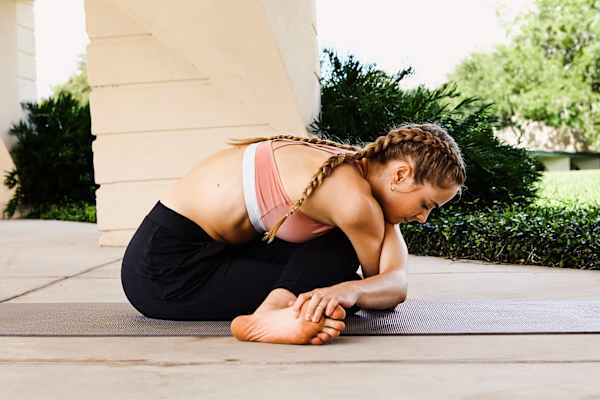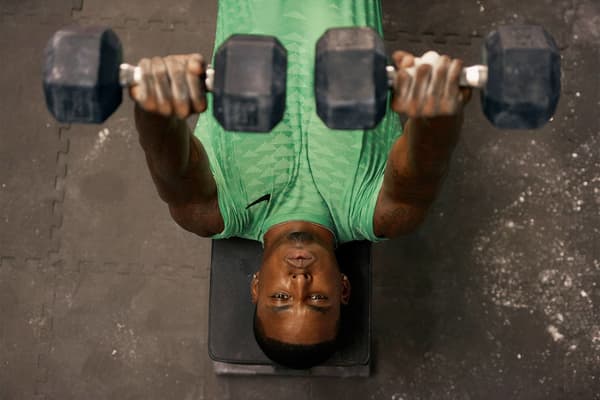5 Benefits of Stretching Daily, According to Experts
Sport & activity
Learn why flexing and extending your muscles, joints and tendons is an essential part of your workout.

Sometimes when you're short on time, pre- and post-workout stretching can be the first thing to get cut from your workout. But many experts argue that it's an important component of any routine—and shouldn't be skipped.
"Along with optimising your athletic performance, daily stretching increases your comfort during [daily] activities by promoting flexibility and mobility, which can ultimately decrease your risk of injury and chronic pain", says Marissa Miller, an ACE-certified personal trainer. "The same way you can't go to the gym once and see muscles pop up later that same day, you must stretch regularly to notice a difference in your range of motion".
Daily stretching also helps promote tension release, adds Ellen Barrett, a Kripalu-certified yoga teacher and ACE-group exercise-certified instructor. "Stretching can release and soothe muscular tension, especially in the shoulders and neck. Most people don't even realise how tight they are until they intentionally stretch", she says. "In fact, the time spent putting attention on stretching can have a positive mind [and] body effect".
First, let's distinguish the key differences between the two basic forms of stretches.
Dynamic vs Static Stretching
Miller explains that dynamic stretching involves performing movements in a full range of motion that stretch both the joints and ligaments without ever holding a specific pose.
"Like any type of exercise, you want to ease into a full range of motion when stretching dynamically, eventually working your way up", says Miller.
She adds that while someone who's more conditioned may feel comfortable diving into semi-to-full-range-of-motion stretches straight off the bat, others may choose to limit the range of motion and keep it strictly low impact to reduce pressure on weight-bearing joints. For example, a beginner-friendly, low-impact stretch could be a jumping jack minus the jumping—instead, step each foot out to the side while lifting and lowering your arms in a range that feels comfortable.
Miller also explains that stretching the joints can help prime (or lubricate) them for the workout, but it's important to note that not all joints work in the same way. "Some favour mobility, like ball-in-socket synovial joints at the shoulder or glenohumeral joint and hip, while others favour stability and motion in one plane, like the elbow and knee".
RELATED: The 7 Best Stretches for Shin Splints
"When stretching dynamically, you'll be practising the training method called specificity, which primes your muscles, joints and ligaments for exercises targeting those same areas", she says. "Since your muscles are cold before working out, you'd want to stick to dynamic stretching in order to prevent tearing".
Another reason why dynamic stretching is likely to be done before exercising is because it may increase your body temperature, says Keri Gans, RDN, a vinyasa-certified yoga teacher. "Examples of dynamic stretching would be walking leg lunges, moving torso twists, cat/cow or arm circles", she says.
Static stretching involves holding a stretch for a period of time (usually between 10 and 30 seconds), says Gans, and should primarily be reserved for the cool-down. "These stretches are typically done when the body is already warm", she adds.
Examples of static stretches include lying on your back with one leg elevated and a strap around the ball of your foot, as well as Anjaneyasana pose (low lunge) or extended Child's pose.
Tips for Stretching
There are a few basic guidelines to follow when stretching. For starters, the experts emphasise the importance of listening to your body.
"If something doesn't feel right, back off", says Gans. "A stretch that might be ideal for one person's body might not be the same for another".
Barrett concurs, adding that "the person stretching is the only one who knows how deeply to stretch". Miller also points out that while a stretch might be slightly uncomfortable, it should never hurt. She also emphasises showing all the sections of your body some love—arms, legs, quads, hamstrings, you name it. "This will help to avoid any imbalances that can eventually lead to overcompensation and injury on one side", she says.
Remembering to breathe as you do any type of stretch will enable you to reap extra benefits. "Taking deep, long breaths promotes oxygen delivery to your joints and muscles, allowing you to safely sit deeper in the stretch", says Miller.
All three experts recommend steering clear of ballistic stretching, which consists of bouncing in and out of a stretched position.
"Bouncing during stretching can apply pressure on the joints or tendons and cause them to tighten—which negates the purpose of the stretch in the first place", says Miller. "It may also cause you to sit too deeply [and] too quickly in a stretch, since it reduces your ability to control your movements. [This] can result in a higher risk of injury, like a sprain, tear or tightness on the working side, or overcompensation and muscular imbalances on the other side".
According to the stretching and flexibility guidelines from the American College of Sports Medicine, stretching exercises should be done at least two to three times a week, while "daily stretching is most effective".
5 Potential Benefits of Stretching Daily
1.Can Boost Brain Health
A 2019 study published in SAGE Journals found that stretching can have a positive effect on mood and cognitive skills. After young, inactive adults took part in 10 minutes of yoga techniques and stretching poses, they reported lower rates of tension, anxiety, depression, anger, fatigue and confusion. Plus, the study authors noted an association between better mood and improved cognitive performance, such as learning, thinking, remembering, problem solving and decision making.
While the authors say that further research is necessary to determine the exact mechanisms, they also speculate that stretching can alter neurotransmitters in the brain, such as serotonin (a hormone that's involved in mood and emotions). They also noted that study participants' tension-anxiety scores decreased after just 10 minutes of stretching.
"When we're stressed, we begin to tense our muscles in response", says Miller. "Lengthening those tensed up muscles can send a message to our brain that we are not in danger, and we can relax".
Don't miss The Top Benefits of Foam Rollers, According to Experts!
2.Can Reduce Back Pain
Back pain is a common condition that affects eight out of 10 US adults at some point in their lives. A 2015 study in the Journal of Physical Therapy Science discovered that participants who suffered from posture-related back, shoulder, neck or pelvis pain and who practised a 20-minute exercise routine focused on stretching reported lower pain levels in the first week after performing those moves.
The authors point to similar findings from other studies, including a trial where volunteers experienced significantly reduced pain levels in the neck and shoulders after four weeks of practising stretching exercises.
Also, researchers from the United Kingdom who conducted a systematic review in 2016 found that an exercise consisting of flexibility, muscular strength and aerobics can aid in non-specific chronic back pain. More specifically, the findings suggest that stretching the back muscles and ligaments can help increase range of motion and, as a result, lead to better movement patterns.
3.Has Been Shown to Improve Sleep Quality
A group of international researchers analysed the possible effects stretching and resistance training could have on chronic insomnia, a sleep disorder that affects between 10–30 percent of US adults, according to the Sleep Foundation.
The results—which were published in the Brazilian Journal of Psychiatry in 2019—found that participants who stretched and trained saw "significantly greater improvements" in insomnia severity, sleep latency (the time it takes to doze off), wake after sleep onset and sleep efficiency, as well as improved sleep duration compared to those in the control group.
4.Can Promote Heart Health
Leg stretching may lead to profound cardiovascular benefits, suggests one 2020 study in the Journal of Physiology. The study authors divided healthy adults into two groups. One group stretched five times a week (movements that focused on the hips, knees and ankles) over a 12-week period, while the other group did not stretch.
Once the trial concluded, the researchers discovered that the stretching group had better blood flow, reduced arterial stiffness and lower blood pressure. Since reduced blood flow is a risk factor for cardiovascular disease, diabetes and stroke, the authors suggest that routine leg stretching may ward off these conditions and could be beneficial for those at high risk with limited mobility.
5.May Help Support Mobility in Older Individuals
"I've seen it with myself and with clients", says Barrett. "Stretching helps increase—or at least maintain—mobility, and mobility is a key to youthfulness and functionality".
According to a systematic review and meta-analysis of 24 clinical trials published in the journal Topics in Geriatric Rehabilitation, older adults who stretched on a regular basis showed improved gait speed, range of motion of hip flexors and ankle dorsiflexion (pulling the foot up toward the nose) compared to the control group. The researchers added that stretching could be a way to counteract age-related decline in mobility.
"As we age, our muscles and connective tissues tend to tighten, so daily stretching can offset some of that discomfort while optimising your flexibility", says Miller.
For more tips on how you can incorporate more stretching into your weekly workout routine, download the Nike Training Club App!
Words by Amy Capetta






















